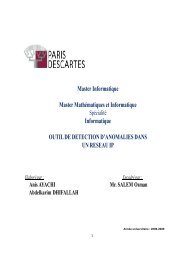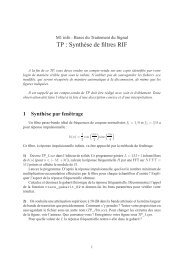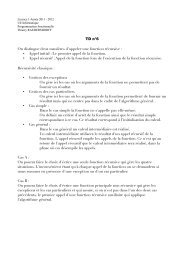Th`ese de Doctorat de l'université Paris VI Pierre et Marie Curie Mlle ...
Th`ese de Doctorat de l'université Paris VI Pierre et Marie Curie Mlle ...
Th`ese de Doctorat de l'université Paris VI Pierre et Marie Curie Mlle ...
Create successful ePaper yourself
Turn your PDF publications into a flip-book with our unique Google optimized e-Paper software.
of which there exist extensive theories and algorithms such as the Karush-Kuhn-Tucker<br />
conditions and duality theorem.<br />
Kelly has suggested in [7] that the problem of bandwidth allocation should be posed<br />
as one of achieving maximum aggregate utility for the users. These users are assumed to<br />
be of elastic traffic, and can adjust their rates based on the feedback from the n<strong>et</strong>work.<br />
Further, in [7], pricing is used to <strong>de</strong>compose the overall problem into subproblems for the<br />
n<strong>et</strong>work and for the individual users.<br />
Authors in [14] have also investigated the problem of achieving the optimal bandwidth<br />
allocation that maximizes the aggregate utility of the users, using only the information<br />
available at the end hosts. The users are assumed of elastic traffic, but differently from [7],<br />
in [14], the users adjust their rates based on their estimates of n<strong>et</strong>work congestion level.<br />
On the other hand, the authors in [15] have addressed the problem of allocating trans-<br />
mission data rates distributedly to users who have concave as well as sigmoidal utility<br />
functions, to take into account the behavior of different applications. Moreover, it is<br />
<strong>de</strong>monstrated in [15] that applying rate control algorithms <strong>de</strong>veloped for concave utility<br />
functions in a more realistic s<strong>et</strong>ting can lead to instability and high n<strong>et</strong>work congestion.<br />
In our service mo<strong>de</strong>l, we do not restrict the utility functions to be concave; in line<br />
with [15], we allow users to have more general utility functions that arise naturally in<br />
the context of various applications. However, to solve the problem of extra-bandwidth<br />
allocation, we distinguish b<strong>et</strong>ween two cases: 1) all users have concave utility functions; or<br />
2) users have concave as well as non concave utility functions. In the first case, we propose<br />
a mathematical formulation of the bandwidth allocation problem that maximizes the total<br />
n<strong>et</strong>work revenue, while in the second case we introduce two heuristic online measurement-<br />
based bandwidth allocation algorithms.<br />
In [2], a generic pricing structure is presented to characterize the pricing schemes cur-<br />
rently used in the Intern<strong>et</strong>, and a dynamic, congestion-sensitive pricing algorithm is in-<br />
troduced to provi<strong>de</strong> an incentive for multimedia applications to adapt their transmission<br />
27










